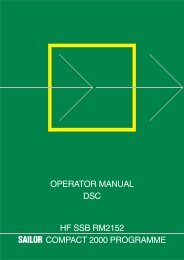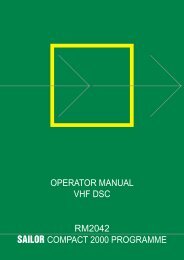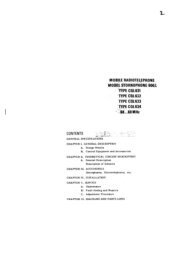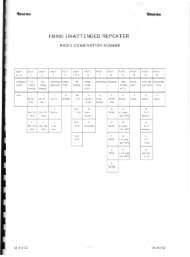TECHNICAL MANUAL FOR COMPACT VHF DSC RM2042
TECHNICAL MANUAL FOR COMPACT VHF DSC RM2042
TECHNICAL MANUAL FOR COMPACT VHF DSC RM2042
You also want an ePaper? Increase the reach of your titles
YUMPU automatically turns print PDFs into web optimized ePapers that Google loves.
<strong>RM2042</strong>5 CIRCUIT DESCRIPTION AND SCHEMATIC DIAGRAMS5.1 INTERFACE (MODULE 1) PART NO. 626941All connections to external equipment and the corresponding interface circuits are located at the interfacemodule. The interface circuits are in this discription divided into the following blocks, which again aredivided into an analog and a digital groupe:Analog interfaceLoudspeaker amplifierBalanced TX AF amplifierUnbalanced TX AF amplifier12V/24V wiring circuit5V power supplyPower failure reset circuitDigital interfaceS.P. bus interfacePrinter interfaceC2149/PC interfaceNMEA interface (Navigational equipment interface according to the National Marine ElectronicsAssociation)LOUDSPEAKER AMPLIFIERThe loudspeaker amplifier is build-up around the integrated power amplifier TDA7052 (U4), which hasa voltage gain of about 40dB and is able to deliver about 0.5 Watt into an 8 ohm loudspeaker.In a normal operation situation, where no call signal has been detected, the received signal from theexternal connected <strong>VHF</strong> or the build-in channel-70 receiver will be leaded to the internal loudspeaker. Thereceived signal comming from the receiver module is buffered by an operational amplifier (U3.4) and isthen led to the volume control at the front panel, where it is attenuated. The attenuated signal is bufferedat the interface module by the transistor Q8 and then finaly led to the power amplifier and loudspeaker.If a call signal (distress or ordinary) is received, the microprocessor will generate an indication signal(gated 600Hz tone) that will be leaded to the loudspeaker instead of the received signal. The receivedsignal is removed from the loudspeaker by means of the transistor Q3, which at the same time isgrounding the signal and removing the bias for the buffer transistor Q8. The controle signal to transistorQ3 is generated by the printer interface unit U10 and is filtered by R13, R14 and C52 to avoid a suddenlychange in the bias of transistor Q8, which else would result in an irritating “DC-blop” in the loudspeaker.BALANCED TX AF AMPLIFIERThe <strong>VHF</strong> <strong>DSC</strong> <strong>RM2042</strong> has two seperate transmitter outputs - an unbalanced with a low generatorimpedance and a balanced with a 600 ohm generator impedance. To establish a balanced connectionbetween <strong>RM2042</strong> and the connected <strong>VHF</strong> radiotelephone, it will be necessary to use two wires, while anunbalanced connection only requires one. Because the number of wires in the connection cable is limitto nine and all are in use, it is necessary to change the function of the serial data bus and use this as thesecond wire in the balanced connection. As a consequence, the balanced connection can not be usedin instalations where <strong>RM2042</strong> is connected to the duplex <strong>VHF</strong> radiotelephone RT2047 or the simplex <strong>VHF</strong>radiotelephone RT2048, because the serial data communication is essential in these cases. Theswitching between balanced and unbalanced mode is done manualy by turning the switch S1 with ascrewdriver or equal.The input signal to the balanced TX AF amplifier is a FSK-signal (Frequency-Shift Keying signal), whichis generated by the MODEM-IC located at the Receiver Module. This FSK-signal is led to the operationalamplifier (U3.2) and the transistor Q4 at the Interface Module. The feedback signal to the OP AMP is takenfrom the emitter of Q4, which minimize the harmonic distortion. The balance is obtained by means of thetransformer TR1, which is placed between the battery voltage and the collector of Q4. The output levelis adjustable from -10dBm to +10dBm (600 ohm) and is controlled by the trimming potentiometer R17.9716PAGE 5-1
















